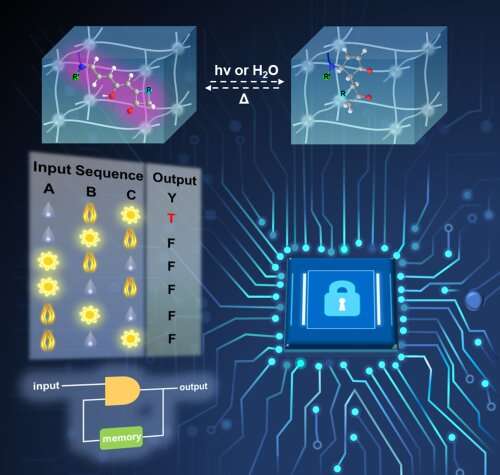Credit: Chinese Academy of Sciences
A team of researchers at the Chinese Academy of Sciences, working with a colleague from the State University of New Jersey, has developed a gel-based code-hiding system that uses combinations of water, light and heat to hide and reveal hidden codes. In their paper published in the journal Science Advances, the group describes how their gel is made and the possible uses for it.
A variety of techniques are used to keep sensitive information safe from prying eyes—requiring passcodes before gaining access to a bank account, for example. Other techniques are required to prevent counterfeiting of sensitive documents, such as passports or paper money. Currently, most methods that have been developed to prevent counterfeiting involve adding an attribute to the material to be protected—a watermark, for example, that glows under a UV light. In this new effort, the researchers developed a new means for preventing counterfeiting that can also be used to convey passcodes.
The work involved manipulating types of molecules called donor-acceptor Stenhouse adducts (DASAs)—they change from a given color to transparent when exposed to normal light. The researchers created 12 molecules that change from reflecting colors to transparency when exposed to certain combinations of water, light and heat. By allowing for mixing up the amount of each that are used, the three ingredients represent a cypher of sorts. To use such a cypher, the researchers embedded the molecules in a polymer.
In practice, a person would choose desired ratios of light, water and heat and then use the gel as a sort of ink to print number codes onto a piece of paper in the format of numbers displayed on a digital clock. Each of the segments making up a number would have different amounts of DASAs. The ratios would then be divulged only to those people who are supposed to have access to the code.
Such a system could be used to verify the authenticity of documents such as passports or cash money. It could also be used to convey passcodes. Banks, for example, could securely send passwords to customers via printed documents. The researchers suggest their gel could prove useful in a wide variety of applications because it would be difficult to mimic the conditions needed to access the hidden data.
More information: Yu Dong et al, Harnessing molecular isomerization in polymer gels for sequential logic encryption and anticounterfeiting, Science Advances (2022). DOI: 10.1126/sciadv.add1980
Journal information: Science Advances
© 2022 Science X Network
























